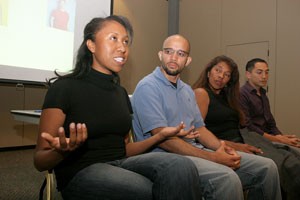Students, faculty and staff listened to stories of hardship from mixed race individuals as a way to bring light and understanding to issues dealing with race in this generation.
The discussion yesterday, “”Oreos, Vanilla Wafers, Apples, and Bananas: Mixed-Race Discussion Panel”” was put on by the Social Justice Leadership Center in the Tucson Room of the Student Union Memorial Center.
“”I’m here to learn about the issues facing mixed race individuals and how it applies to society today,”” said Michael Gardner, a journalism sophomore. “”It is obvious that diversity is here to stay so everyone should just embrace it.””
Members of the panel opened the discussion by stating how they viewed themselves and went on throughout the discussion telling stories of the hardships they faced as multiracial individuals.
“”Because of the way I talked and the fact that I was not good at typical black things like basketball, kids would call me white-washed,”” said Derek Adams, a graduate student whose mother is white and biological father is half-white, half-black. “”It was around that time I realized I was neither black nor white, but I was just different. I was multiracial.””
According to slides playing while the panel discussed the issues, 6.8 million people in the U.S. identify themselves as biracial individuals, a number that is increasing every year.
This is in part due to the fact that interracial marriages are increasing as well. Approximately 7 percent of all marriages in 2002 were multiracial.
“”My parents were not allowed to get married in Tucson when they originally wanted to because my father was black and my mother was Native American,”” said Kathryn Forster, a panelist at the discussion. “”It wasn’t until 1952 they could be married.””
The panelists all seemed to share the opinion that they did not realize they were different until people began pointing it out to them.
“”A lot of how you identify yourself comes from how other people identify you, whether it be what race you are or even what group you fit into at school,”” said Linda Imonode, a law student whose father is from Nigeria and whose mother is from Mexico. “”People generally want to put you into what group you look most like and they want you to identify yourself as part of that group early on. The problem is though that some of us don’t fit into only one group.””
Marc Johnston, director of the UA’s Asian Pacific American Student Affairs and the child of a white father and a Filipino mother, agreed.
“”I always felt different and there were not a lot of Filipinos where I was from,”” Johnston said. “”At one point because people told me I looked Latino I tried to identify with them. But, once I got to Michigan State I joined the Filipino student organization there and realized I was not entirely like them either.””
Johnston explained his story of how he ended up feeling he was over compensating to be like the other Filipino students, but finally learned to embrace his mixed heritage.
“”It’s just something you deal with because you never really see yourself as different until others point it out and ask you what you are,”” Johnston said.
The panel seemed to be in agreement about many things, including how different areas of the country respond differently to mixed races.
According to U.S. Census data and the slideshow that was presented, Hawaii has the highest number of mixed-race individuals with 32.32 percent of individuals identifying themselves that way.
Alaska has the second highest number at a distant 5.4 percent of people who identify themselves as mixed race.
“”When I was in New York it was never a big deal,”” Imonode said. “”Because they have large Haitian and Dominican populations and those groups have an African presence no one questioned me. Plus I think they were all so busy with their own lives it didn’t matter.””









